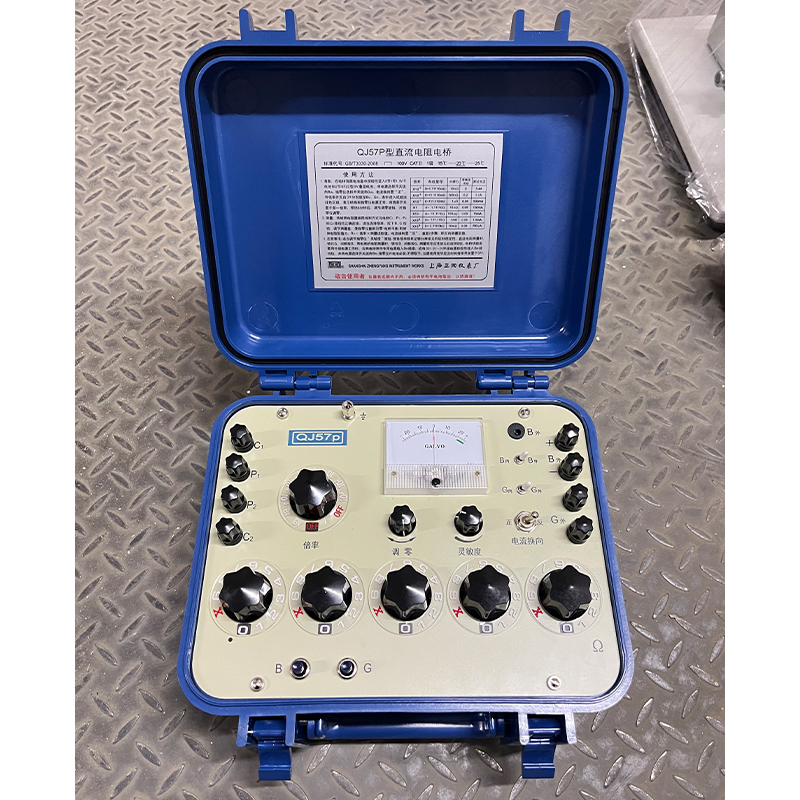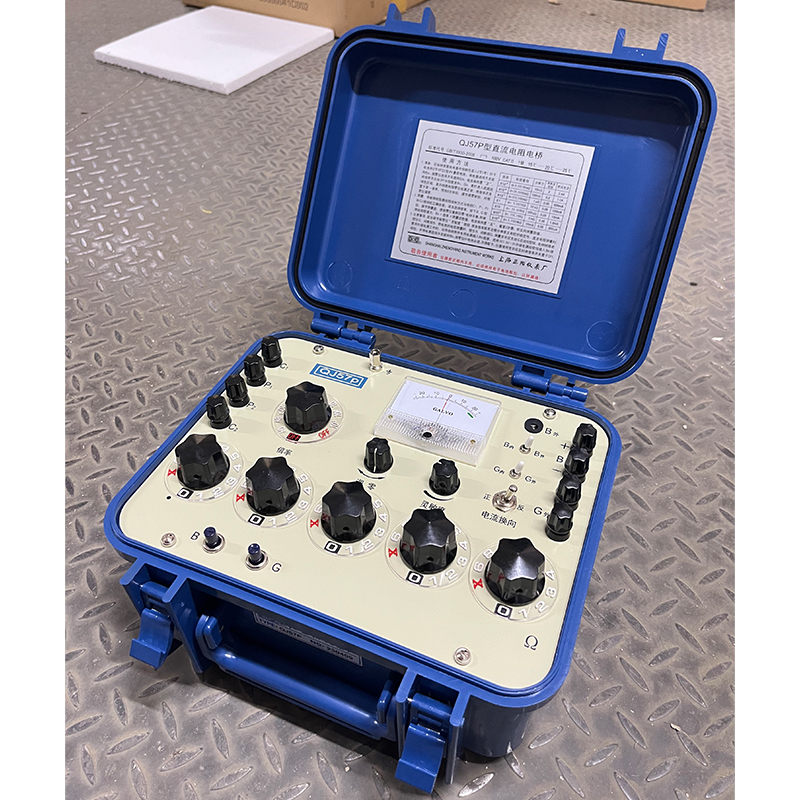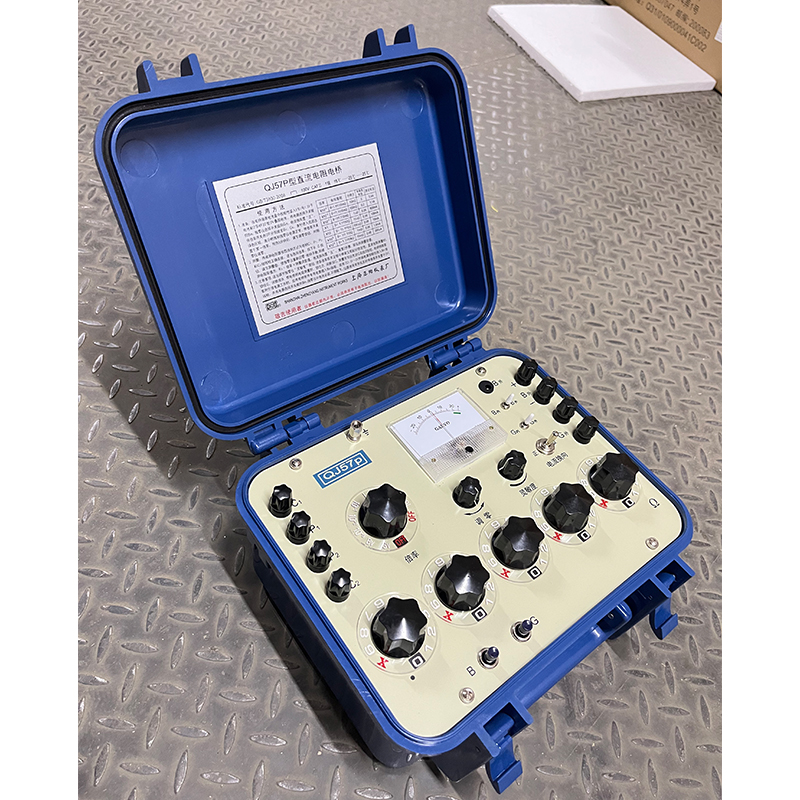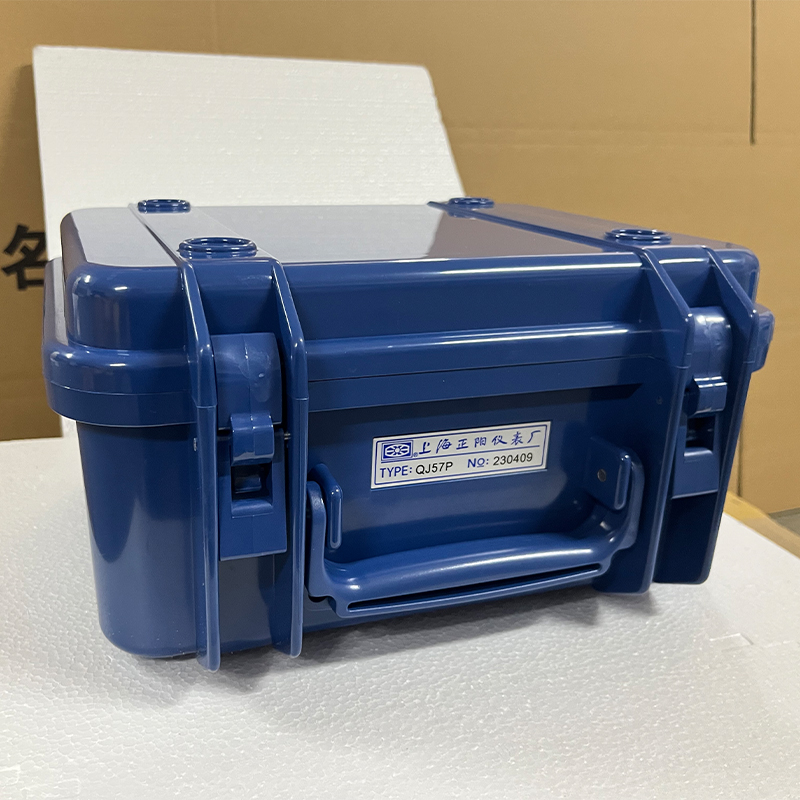QJ57P DC Resistance Measuring Instrument | Accurate & Fast
In an era defined by electrification and high-performance electronics, the precision of component measurement is not just a quality metric—it's the bedrock of safety, efficiency, and innovation. The QJ57P DC Resistance Measuring Instrument emerges as the definitive tool for engineers, quality control specialists, and researchers who demand uncompromising accuracy. This comprehensive guide explores every facet of the QJ57P, from its advanced technical specifications to its real-world applications, showcasing why it is the industry-leading choice for low-resistance measurement.

Industry Trends: The Escalating Need for Precision DC Resistance Measurement
The global industrial landscape is undergoing a significant transformation. Key trends are magnifying the importance of precise DC resistance testing:
- Electrification of Everything: From electric vehicles (EVs) to renewable energy systems (solar panels, wind turbines), the demand for high-efficiency conductors, motors, and batteries is soaring. A minute deviation in resistance can lead to significant energy loss, heat generation, and potential failure. Instruments like the **QJ57P DC Resistance Measuring Instrument** are critical for R&D and quality control in these sectors.
- Miniaturization and Complexity: Electronic components are becoming smaller and more complex. Measuring the resistance of micro-connectors, PCB traces, and fine-gauge wires requires instruments with high sensitivity and resolution to ensure signal integrity and proper function.
- Stricter Quality and Safety Standards: International standards such as those from the IEC (International Electrotechnical Commission) and ANSI (American National Standards Institute) are becoming more stringent. Compliance requires verifiable, accurate data, a core function of the QJ57P DC Resistance Measuring Instrument. According to a 2023 report by Global Market Insights, the Test and Measurement Equipment market is projected to exceed $35 billion by 2030, driven largely by quality assurance needs in the electronics and automotive industries.
- Material Science Advancements: The development of new alloys and composite materials for conductors necessitates advanced testing to characterize their electrical properties accurately. Research labs rely on high-precision ohmmeters for material validation.
Core Technical Specifications: A Deep Dive into the QJ57P's Capabilities
The performance of a measuring instrument is defined by its specifications. The QJ57P DC Resistance Measuring Instrument is engineered with state-of-the-art components to deliver exceptional results. Below is a detailed breakdown of its key parameters.

| Parameter | Specification | Significance & Industry Impact |
|---|---|---|
| Measurement Principle | Kelvin Four-Wire Bridge Method | Eliminates the influence of test lead and contact resistance, ensuring true measurement of the sample. This is an absolute requirement for low-resistance measurements as per IEC 60468 standard. |
| Measurement Range | 0.1μΩ to 2MΩ | Extremely wide range covers applications from heavy-duty busbars and transformer windings (micro-ohms) to insulation contactors and resistive sensors (kilo/mega-ohms). |
| Highest Resolution | 0.01μΩ | Enables detection of minute changes in resistance, crucial for quality control in high-purity copper wires or sensitive electronic components. |
| Basic Accuracy | ±0.02% of reading + 0.005% of range | Provides laboratory-grade precision for R&D and calibration tasks, ensuring high confidence in measurement results and compliance with the strictest quality standards. |
| Selectable Test Current | 1μA to 10A | Allows for optimizing the test current based on the sample's material and size, preventing sample heating on sensitive components while providing sufficient current for stable readings on large conductors. |
| Temperature Compensation | -10°C to 100°C (with PT100 sensor input) | Automatically corrects resistance readings to a standard temperature (e.g., 20°C), a critical feature since the resistance of metals like copper and aluminum is highly temperature-dependent. This removes a major source of error in factory environments. |
| Inductive Load Testing | Specialized modes for motors, transformers | Features advanced circuitry and algorithms to quickly charge the inductive component and achieve a stable reading, dramatically reducing test time compared to standard ohmmeters. |
| Display | 7-inch High-Resolution Color LCD Touchscreen | Provides a clear, intuitive user interface for setup, real-time data visualization, and results storage. Simplifies operation and reduces user error. |
| Interfaces | USB, RS-232, LAN (with SCPI command support) | Enables seamless data logging to a PC and integration into automated test systems (ATE) for production line testing. |
| Certifications | CE, ISO 9001:2015 Manufacturing Standard | Demonstrates compliance with European safety standards and a commitment to a rigorous quality management system. |
Data Visualized: The QJ57P Performance Edge
Chart 1: Accuracy Comparison
This chart illustrates the superior accuracy of the QJ57P DC Resistance Measuring Instrument (±0.02%) compared to typical handheld meters and standard benchtop competitors. Lower error percentage signifies higher precision and reliability.
Chart 2: Application Distribution
The versatility of the QJ57P DC Resistance Measuring Instrument makes it suitable for a wide range of industries. This chart shows a typical distribution of its application based on our customer data.
- 40% - Wire & Cable Manufacturing
- 30% - Transformer & Motor Testing
- 20% - Aerospace & Automotive Components
- 10% - R&D and Material Science
Unveiling the Manufacturing Process: Precision from Inception
The exceptional quality of the QJ57P DC Resistance Measuring Instrument is not accidental; it is the result of a meticulous, multi-stage manufacturing and quality assurance process that adheres to ISO 9001 standards. Each step is designed to build in precision and reliability.
1. Component Sourcing
We select only high-stability, low thermal-coefficient components, including precision foil resistors and reference-grade ICs, from certified suppliers.
2. SMT & PCB Assembly
Automated Surface-Mount Technology (SMT) lines ensure consistent solder joints and component placement on multi-layer PCBs designed for minimal noise.
3. Enclosure & Assembly
The robust enclosure is crafted from high-grade, anodized aluminum using CNC machining for a perfect fit, providing excellent EMI shielding and durability.
4. Calibration & Burn-In
Each unit undergoes a multi-point calibration against traceable standards (e.g., Fluke calibrators). A 72-hour burn-in test at elevated temperatures ensures long-term stability.
5. Final QC & Testing
A final, comprehensive quality control check verifies all functions, accuracy across all ranges, and interface connectivity, culminating in a signed Certificate of Calibration.

Versatile Application Scenarios: Where the QJ57P Excels
The QJ57P DC Resistance Measuring Instrument is not a one-trick pony. Its advanced features provide tangible benefits across a spectrum of demanding industries.
Wire and Cable Manufacturing
In this industry, DC resistance is a fundamental parameter that determines the conductor's quality and current-carrying capacity (ampacity), as specified by standards like ASTM B193. The QJ57P is used to:
- Verify Conductor Quality: Ensure raw material (copper, aluminum) meets purity specifications.
- Production Line QC: Test finished cables to confirm they meet resistance-per-length requirements.
- Cost Savings: Precise measurements help optimize conductor cross-section, saving tons of valuable copper annually without compromising safety.
Transformer and Motor Manufacturing
The resistance of windings is a critical indicator of a transformer's or motor's health and efficiency. The QJ57P's inductive measurement mode is invaluable for:
- Winding Integrity Checks: Detecting shorted turns, poor connections, or incorrect wire gauge.
- Heat Run Tests: Measuring resistance before and after load tests to calculate temperature rise.
- Predictive Maintenance: Monitoring resistance changes over time to predict potential failures in large power transformers.

Aerospace and Automotive
In these safety-critical sectors, every connection counts. The QJ57P ensures the reliability of:
- Electrical Bonding: Verifying low-resistance paths between aircraft fuselage sections for lightning protection.
- Battery Pack Connections: Measuring the resistance of busbar welds and connections in EV battery packs to minimize power loss and heat generation.
- Switch and Relay Contacts: Assessing contact resistance to ensure reliable operation over millions of cycles.
Electronics and R&D
For researchers and designers, the QJ57P is an indispensable tool for:
- Material Characterization: Measuring the resistivity of new conductive materials and alloys.
- Component Testing: Verifying the resistance of fuses, shunts, and PCB traces.
- Superconductivity Research: Measuring near-zero resistance at cryogenic temperatures.
Technical Advantages & Manufacturer Comparison
What sets the QJ57P DC Resistance Measuring Instrument apart from the competition? It's a combination of superior technology, robust design, and user-centric features.
| Feature | QJ57P DC Resistance Measuring Instrument | Standard Benchtop Ohmmeter | Handheld Meter |
|---|---|---|---|
| Accuracy | ±0.02% (Laboratory Grade) | ±0.1% - 0.5% | ±1% - 2% |
| Measurement Method | 4-Wire Kelvin with Lead Compensation | Often 4-wire, limited compensation | Typically 2-wire (inaccurate for low Ω) |
| Inductive Load Handling | Fast, Stable Measurement Mode | Slow to stabilize, may be unstable | Not suitable, can damage meter |
| Temperature Compensation | Automatic (External PT100 input) | Manual entry or none | None |
| Automation Interface | USB, RS232, LAN (SCPI) | Limited (RS232 or USB only) | None |
| Build Quality & Shielding | CNC Aluminum Chassis, EMI Shielded | Plastic or sheet metal | Plastic |
Customization and Integrated Solutions
We understand that one size does not fit all. Our engineering team has over 15 years of experience in providing tailored solutions. The QJ57P DC Resistance Measuring Instrument platform can be adapted to your specific needs:
- Custom Test Fixtures: We design and build custom jigs and fixtures for securely and repeatably testing your specific components, from tiny SMD resistors to large motor windings.
- Software Integration (ATE): Our team can assist with integrating the QJ57P into your automated test environment using its standard SCPI command set. We can provide LabVIEW drivers, Python scripts, or other support to streamline your production testing.
- Specialized Measurement Ranges: For unique R&D applications, we can potentially modify the instrument for custom current levels or specialized resistance ranges.

Application Case Study: Volt-Core Cables Inc.
The Challenge: Inconsistent Quality and Material Waste
Volt-Core Cables, a leading manufacturer of high-performance power cables, was facing issues with batch-to-batch consistency. Their older testing equipment lacked the necessary precision, leading to a "safe but wasteful" approach: using slightly more copper than specified to ensure all products passed minimum requirements. This resulted in significant excess material costs annually.
The Solution: Implementing the QJ57P
After a thorough evaluation, Volt-Core integrated three QJ57P DC Resistance Measuring Instrument units into their final QC process. The instrument's high accuracy (±0.02%) and automatic temperature compensation allowed them to tighten their manufacturing tolerances with confidence.
The Results: Measurable ROI
"The QJ57P transformed our quality control. Its precision gave us the data we needed to optimize our process. We've reduced our copper consumption by 1.5% while improving product consistency. The instrument paid for itself in less than six months. It's a testament to the value of investing in quality measurement."
- 1.5% Reduction in copper wire raw material usage.
- 99.98% Pass Rate at final inspection, up from 98.5%.
- 40% Reduction in test time per cable reel due to faster stabilization.

Trust and Authority: Our Commitment to You
Your trust is our most valuable asset. We build it through transparency, expertise, and unwavering support.
✓ ISO 9001 Certified
Our manufacturing processes are rigorously audited and certified, ensuring consistent quality in every unit we produce.
✓ 2-Year Warranty
We stand behind the QJ57P DC Resistance Measuring Instrument with a comprehensive two-year warranty covering parts and labor.
✓ Lifetime Technical Support
Our team of expert engineers is available to assist you with application questions, setup, and troubleshooting for the life of the product.
✓ Traceable Calibration
Every instrument ships with a calibration certificate traceable to international standards, ensuring your measurements are defensible.
Frequently Asked Questions (FAQ)
The Kelvin method uses four separate wires to connect to the object under test. Two wires (current leads) supply a precise current through the object. The other two wires (voltage leads) are placed directly across the measurement points and measure the voltage drop. Since the voltage leads carry virtually no current, the resistance of the leads and the contact points is not included in the voltage measurement. This completely eliminates a major source of error, which is absolutely essential for accurately measuring low resistances (less than 1Ω), where the lead resistance could be larger than the resistance of the sample itself. The QJ57P DC Resistance Measuring Instrument is built around this principle.
The electrical resistance of most conductive materials, especially metals like copper and aluminum, changes significantly with temperature. For copper, resistance changes by about 0.4% for every 1°C change. Without correction, this can lead to massive errors. The QJ57P DC Resistance Measuring Instrument features a dedicated input for an external PT100 temperature probe. When the probe is attached to the sample, the instrument measures the real-time temperature and uses built-in formulas to automatically normalize the resistance reading to a standard reference temperature (e.g., 20°C). This ensures consistent, comparable results regardless of the ambient factory temperature.
A higher test current is beneficial when measuring very low resistances, such as those found in large busbars, transformer windings, or thick cable joints. According to Ohm's Law (V=IR), a higher current (I) produces a larger voltage drop (V) for a given resistance (R). This larger voltage signal is easier for the instrument to measure accurately, improving the signal-to-noise ratio and leading to more stable and repeatable readings. The 10A capability of the QJ57P DC Resistance Measuring Instrument is ideal for these heavy-duty industrial applications.
The instrument's chassis is constructed from CNC-machined, anodized aluminum. This provides several advantages over a plastic or simple sheet metal case:
- Durability: It is extremely robust and resistant to physical damage in industrial environments.
- EMI Shielding: The conductive aluminum enclosure acts as a Faraday cage, shielding the sensitive internal measurement circuits from external electromagnetic interference (EMI) from nearby motors or power lines, which helps maintain measurement integrity.
- Thermal Stability: The aluminum body helps to dissipate heat from internal components, contributing to long-term stability.
To maintain peak accuracy and ensure compliance with quality systems like ISO 9001, we recommend an annual calibration cycle. Each new QJ57P DC Resistance Measuring Instrument is shipped with a calibration certificate valid for one year, traceable to national/international standards. We offer a recalibration service, or it can be performed by any accredited calibration laboratory equipped with the necessary standards.
Yes, absolutely. This is a key feature. Measuring the DC resistance of a highly inductive load like a transformer or motor winding is challenging for standard ohmmeters. The inductance resists the change in current, so it can take a long time for the test current to stabilize. The QJ57P DC Resistance Measuring Instrument has a specialized "inductive measurement mode" that uses a higher voltage to charge the inductor quickly and employs a sophisticated algorithm to detect when the reading is stable, significantly cutting down measurement time from minutes to seconds.
The QJ57P provides the accurate, traceable data needed to comply with a wide range of industry-specific standards, including but not limited to:
- ASTM B193: Standard Test Method for Resistivity of Electrical Conductor Materials.
- IEC 60076-1: Power transformers - Part 1: General (for winding resistance tests).
- IEC 60228: Conductors of insulated cables.
- SAE AS50881: Wiring, Aerospace Vehicle (for bonding & grounding checks).
Further Reading & Industry References
For those interested in delving deeper into the science and standards of DC resistance measurement, the following resources are recommended:
-
"Low-Level Measurements Handbook: Precision DC Current, Voltage, and Resistance Measurements" - A comprehensive guide from Tektronix/Keithley that details the theory and practice of low-level measurements, including the Kelvin method.
Reference Link (General): tek.com/documents/handbook -
IEEE Transactions on Instrumentation and Measurement - A peer-reviewed journal that frequently publishes research on new measurement techniques, instrumentation, and calibration standards relevant to devices like the QJ57P DC Resistance Measuring Instrument.
Reference Link (General): ieee-ims.org/publication -
"Conductor Resistance and the Temperature Correction Factor" - An industry article from the Wire & Cable Technology International magazine, discussing the practical importance of temperature compensation in cable manufacturing.
Reference Link (Example): wiretech.com (General Industry Site)
-
The Role of Tensile Force Testers in Quality Control and Material Science
NewsAug.01,2025
-
Maintenance and Safety Tips for Aging Ovens
NewsAug.01,2025
-
Density Balance in Forensic Science
NewsAug.01,2025
-
Advanced Optical Measurement Technologies
NewsAug.01,2025
-
A Buyer’s Guide to Tensile Test Machines
NewsAug.01,2025
-
Why the Conductor Resistance Constant Temperature Measurement Machine Redefines Precision
NewsJun.20,2025
 Copyright © 2025 Hebei Fangyuan Instrument & Equipment Co.,Ltd. All Rights Reserved. Sitemap | Privacy Policy
Copyright © 2025 Hebei Fangyuan Instrument & Equipment Co.,Ltd. All Rights Reserved. Sitemap | Privacy Policy
